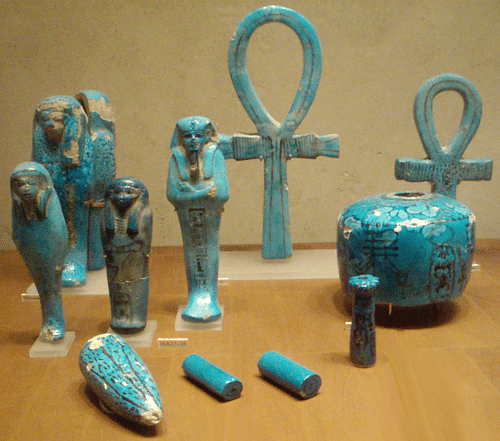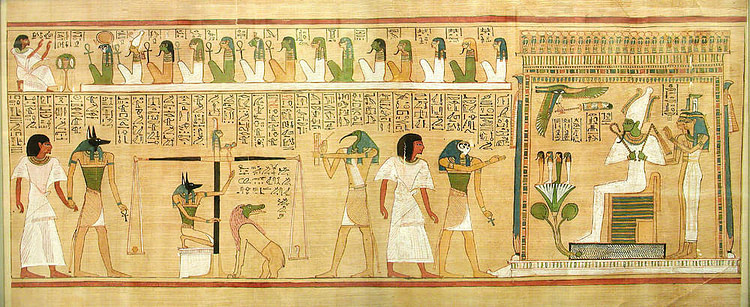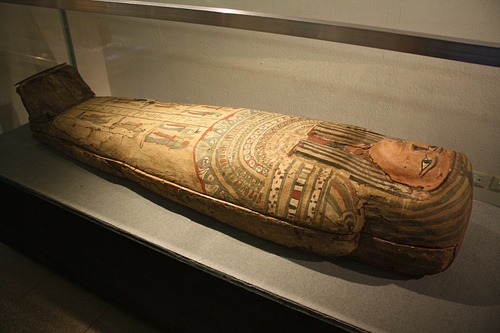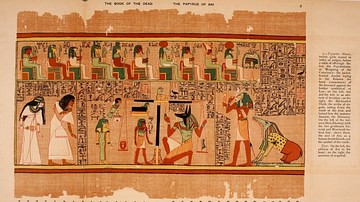Ever since European archaeologists began excavating in Egypt in the 18th and 19th centuries CE, the ancient culture has been largely associated with death. Even into the mid-20th century CE reputable scholars were still writing on the death-obsessed Egyptians whose lives were lacking in play and without joy. Mummies in dark, labyrinthine tombs, strange rituals performed by dour priests, and the pyramid tombs of the kings remain the most prominent images of ancient Egypt in many people's minds even in the present day, and an array of over 2,000 deities - many of them uniquely associated with the afterlife - simply seems to add to the established vision of the ancient Egyptians as obsessed with death. Actually, though, they were fully engaged in life, so much so that their afterlife was considered an eternal continuation of their time on earth.

When someone died in ancient Egypt the funeral was a public event which allowed the living to mourn the passing of a member of the community and enabled the deceased to move on from the earthly plane to the eternal. Although there were outpourings of grief and deep mourning over the loss of someone they loved, they did not believe the dead person had ceased to exist; they had merely left the earth for another realm.
In order to make sure they reached their destination safely, the Egyptians developed elaborate mortuary rituals to preserve the body, free the soul, and send it on its way. These rituals encouraged the healthy expression of grief among the living but concluded with a feast celebrating the life of the deceased and his or her departure, emphasizing how death was not the end but only a continuation. Egyptologist Helen Strudwick notes, "for the life-loving Egyptians, the guarantee of continuing life in the netherworld was immensely important" (190). The mortuary rituals provided the people with just that sort of guarantee.
Early Rituals & Burial
The earliest burials in ancient Egypt were simple graves in which the deceased was placed, on the left side, accompanied by some grave goods. It is clear there was already a belief in some kind of afterlife prior to c. 3500 BCE when mummification began to be practiced but no written record of what form this belief took. Simple graves in the Predynastic Period in Egypt (c. 6000 - c. 3150 BCE) evolved into the mastaba tombs of the Early Dynastic Period (c. 3150 - c. 2613 BCE) which then became the grand pyramids of the Old Kingdom (c. 2613-2181 BCE). All of these periods believed in an afterlife and engaged in mortuary rituals, but those of the Old Kingdom are the best known from images on tombs.
By the time of the Old Kingdom of Egypt, the culture had a clear understanding of how the universe worked and humanity's place in it. The gods had created the world and the people in it through the agency of magic (heka) and sustained it through magic as well. All the world was imbued with mystical life generated by the gods who would welcome the soul when it finally left the earth for the afterlife. In order for the soul to make this journey, the body it left behind needed to be carefully preserved, and this is why mummification became such an integral part of the mortuary rituals. Although it is usually thought that everyone in Egypt was mummified after their death, the practice was expensive, and usually only the upper class and nobility could afford it.
In the Old Kingdom the kings were buried in their pyramid tombs, but from the First Intermediate Period of Egypt (2181-2040 BCE) onwards, kings and nobles favored tombs cut into rock face or into the earth. By the time of the New Kingdom (c. 1570-1069 BCE) the tombs and the rituals leading to burial had reached their highest state of development. There were three methods of embalming/funerary ritual available: the most expensive and elaborate, a second, cheaper option which still allowed for much of the first, and a third which was even cheaper and afforded little of the attention to detail of the first. The following rituals and embalming methods described are those of the first, most elaborate option, which was performed for royalty and the specific rituals are those observed in the New Kingdom of Egypt.
The Preparations
After death, the body was brought to the embalmers where the priests washed and purified it. The mortuary priest then removed those organs which would decay most quickly and destroy the body. In early mummification, the organs of the abdomen and the brain were placed in canopic jars which were thought to be watched over by the guardian gods known as The Four Sons of Horus. In later times the organs were taken out, treated, wrapped, and placed back into the body, but canopic jars were still placed in tombs, and The Four Sons of Horus were still thought to keep watch over the organs.
The embalmers removed the organs from the abdomen through a long incision cut into the left side; for the brain, they would insert a hooked surgical tool up through the dead person's nose and pull the brain out in pieces. There is also evidence of embalmers breaking the nose to enlarge the space to get the brain out more easily. Breaking the nose was not the preferred method, though, because it could disfigure the face of the deceased and the primary goal of mummification was to keep the body intact and preserved as life-like as possible. The removal of the organs and brain was all about drying out the body - the only organ they left in place was the heart because that was thought to be the seat of the person's identity. This was all done because the soul needed to be freed from the body to continue on its eternal journey into the afterlife and, to do so, it needed to have an intact 'house' to leave behind and also one it would recognize if it wished to return to visit.
After the removal of the organs, the body was soaked in natron for 70 days and then washed and purified again. It was then carefully wrapped in linen; a process which could take up to two weeks. Egyptologist Margaret Bunson explains:
This was an important aspect of the mortuary process, accompanied by incantations, hymns, and ritual ceremonies. In some instances the linens taken from shrines and temples were provided to the wealthy or aristocratic deceased in the belief that such materials had special graces and magical powers. An individual mummy would require approximately 445 square yards of material. Throughout the wrappings semiprecious stones and amulets were placed in strategic positions, each one guaranteed to protect a certain region of the human anatomy in the afterlife. (176)
Among the most important of these amulets was the one which was placed over the heart. This was done to prevent the heart from bearing witness against the deceased when the moment of judgment came. Since the heart was the seat of individual character, and since it was obvious that people often made statements they later regretted, it was considered important to have a charm to prevent that possibility.
The Funeral Procession & Service
The embalmers would then return the mummy to the family who would have had a coffin or sarcophagus made. The corpse would not be placed in the coffin yet, however, but would be laid on a bier and then moved toward a waiting boat on the Nile River. This was the beginning of the funeral service which started in the early morning, usually departing either from a temple of the king or the embalmer's center. The servants and poorer relations of the deceased were at the front of the procession carrying flowers and food offerings. They were followed by others carrying grave goods such as clothing and shabti dolls, favorite possessions of the deceased, and other objects which would be necessary in the afterlife.

Directly in front of the corpse would be professional mourners, women known as the Kites of Nephthys, whose purpose was to encourage others to express their grief. The kites would wail loudly, beat their breasts, strike their heads on the ground, and scream in pain. These women were dressed in the color of mourning and sorrow, a blue-gray, and covered their faces and hair with dust and earth. This was a paid position, and the wealthier the deceased, the more kites would be present in the procession. A scene from the tomb of the pharaoh Horemheb (1320-1292 BCE) of the New Kingdom vividly depicts the Kites of Nephthys at work as they wail and fling themselves to the ground.
In the Early Dynastic Period in Egypt, the servants would have been killed upon reaching the tomb so that they could continue to serve the deceased in the afterlife. By the time of the New Kingdom, this practice had long been abandoned and an effigy now took the place of the servants known as a tekenu. Like the shabti dolls, which one would magically animate in the afterlife to perform work, the tekenu would later come to life, in the same way, to serve the soul in paradise.
The corpse and the tekenu were followed by priests, and when they reached the eastern bank of the Nile, the tekenu and the oxen who had pulled the corpse were ritually sacrificed and burned. The corpse was then placed on a mortuary boat along with two women who symbolized the goddesses Isis and Nephthys. This was in reference to the Osiris myth in which Osiris is killed by his brother Set and returned to life by his sister-wife Isis and her sister Nephthys. In life, the king was associated with the son of Osiris and Isis, Horus, but in death, with the Lord of the Dead, Osiris. The women would address the dead king as the goddesses speaking to Osiris.
The boat sailed from the east side (representing life) to the west (the land of the dead) where it docked and the body was then moved to another bier and transported to its tomb. A priest would have already arranged to have the coffin or sarcophagus set up at the entrance of the tomb, and at this point, the corpse was placed inside of it. The priest would then perform the Opening of the Mouth Ceremony during which he would touch the corpse at various places on the body in order to restore the senses so the deceased could again see, hear, smell, taste, and talk.
During this ceremony, the two women representing Isis and Nephthys would recite The Lamentations of Isis and Nephthys, the call-and-response incantation which re-created the moment when Osiris had been brought back to life by the sisters. The lid was then fastened on the coffin and it was carried into the tomb. The tomb would have the deceased's name written in it, statues and pictures of him or her in life, and inscriptions on the wall (Pyramid Texts) telling the story of their life and providing instructions for the afterlife. Prayers would be made for the soul of the deceased and grave goods would be arranged around the coffin; after this, the tomb would be sealed.
The family was expected to provide for the continued existence of the departed by bringing them food and drink offerings and remembering their name. If a family found this too burdensome, they hired a priest (known as a Ka-Servant) to perform the duties and rituals. Lists of food and drink to be brought were inscribed on the tomb (Offering Lists) as well as an autobiography of the departed so they would be remembered. The soul would continue to exist peacefully in the next life (following justification) as long as these offerings were made.
The priests, family, and guests would then sit down for a feast to celebrate the life of the departed and his forward journey to paradise. This celebration took place outside of the tomb under a tent erected for the purpose. Food, beer, and wine would have been brought earlier and was now served as an elaborate picnic banquet. The deceased would be honored with the kind of festival he or she would have known and enjoyed in life. When the party concluded, the guests would return to their homes and go on with life.
Journey to the Afterlife
For the soul of the departed, however, a new life had just begun. Following the mortuary rituals and the closing of the tomb, the soul was thought to wake in the body and feel disoriented. Inscriptions on the wall of the tomb, like the Pyramid Texts, or in one's coffin, as with the Coffin Texts, would remind the soul of its life on earth and direct it to leave the body and move forward. These texts were replaced in the New Kingdom of Egypt by the Book of the Dead. One of the gods, most often Anubis, would appear to lead the soul forth toward the Hall of Truth (also known as The Hall of Two Truths) where it would be judged.
Depictions of the judgment frequently show a long line of souls waiting for their moment to appear before Osiris and these are cared for by deities like Qebhet, who provided them with cool, refreshing water. Familiar goddesses like Nephthys, Isis, Neith, and Serket would also be there to comfort and encourage the soul.

When one's time came, one would move forward to where Osiris, Anubis, and Thoth stood by the scales of justice and would recite the Negative Confessions, a ritual list of sins one could honestly say one had not committed. At this point one's heart was weighed in the balance against the white feather of truth; if one's heart was lighter than the feather, one was justified, and if not, the heart was dropped to the floor where it was eaten by the monster Amut and the soul would then cease to exist.
If one had been justified by the weighing of the heart, Osiris, Thoth, and Anubis would confer with the Forty-two Judges and then allow one to pass on toward paradise. This next part of the journey takes different forms depending on different texts and time periods. In some versions, the soul must still avoid pitfalls, demons, and dangers, and required the assistance of a guide book such as The Egyptian Book of the Dead. In other depictions, once one had been justified, one went to the shores of Lily Lake where a final test had to be passed.
The ferryman was an eternally unpleasant man named Hraf-hef to whom the soul needed to be kind and gracious. If one passed this final test, one was rowed across the lake to paradise in the Field of Reeds. Here the soul would find everything and everyone thought to be lost through death. Those who had passed on before would be waiting as well as one's favorite pets. The house the soul had loved while alive, the neighborhood, friends, all would be waiting and the soul would enjoy this life eternally without the threat of loss and in the company of the immortal gods. This final paradise, however, was only possible if the family on earth had performed the mortuary rituals completely and if they continued to honor and remember the departed soul.







